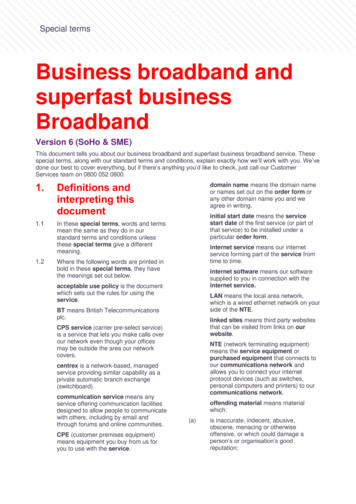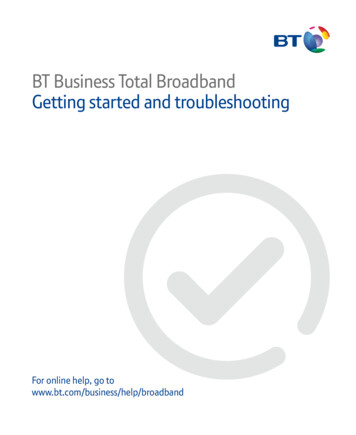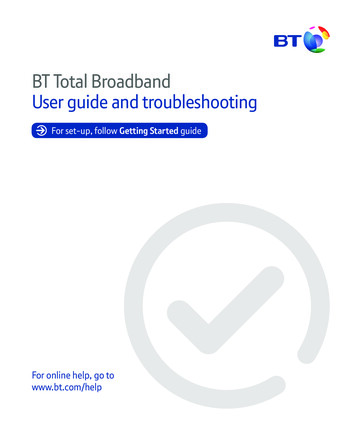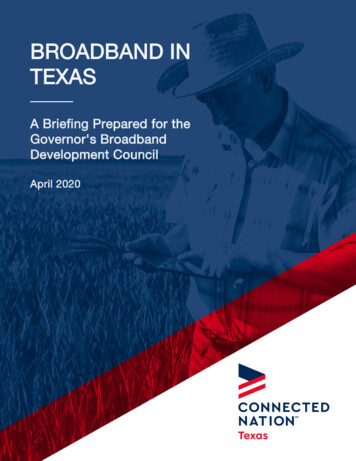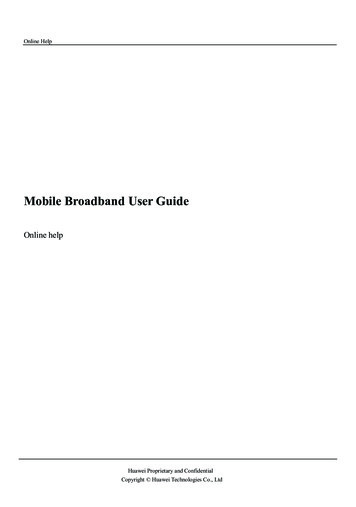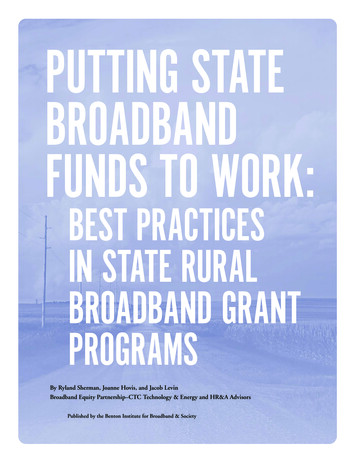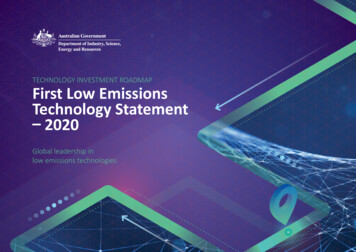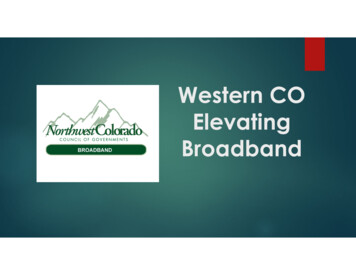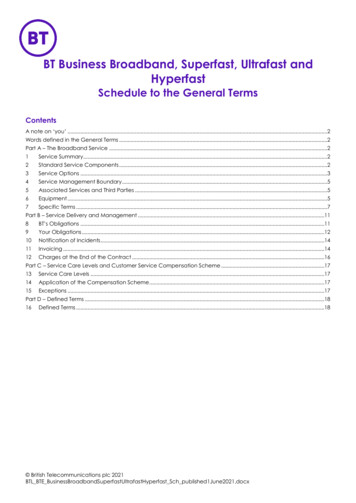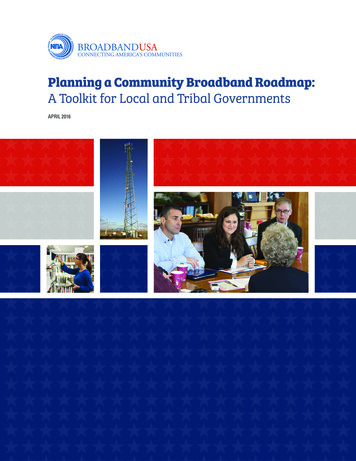
Transcription
Planning a Community Broadband Roadmap:A Toolkit for Local and Tribal GovernmentsAPRIL 2016
U.S. Department of CommercePenny PritzkerSecretary of CommerceNational Telecommunications and Information Administration (NTIA)Lawrence E. StricklingAssistant Secretary of Commerce for Communications and InformationOffice of Telecommunications and Information Applications (OTIA)Doug KinkophAssociate AdministratorBroadbandUSA Project TeamJean RiceSenior Broadband Program SpecialistKaren PerrySenior Program Communications Program SpecialistEmy TsengSenior Broadband Development OfficerDon Williams, Ph.D.Senior Broadband Development OfficerSusan BednarczykEditorThe Project Team would like to thank the other members of the BroadbandUSA team for their efforts and support.DisclaimerAny reference in this document to any non-government entity, product, service, or information does not constitute an endorsement orrecommendation by the U.S. Department of Commerce, the National Telecommunications and Information Administration, or any ofits employees.
ContentsCONTENTSForeword 1Introduction to Broadband Planning 2What is a Community Broadband Roadmap? 2How to Use the Toolkit 2Six Steps: Planning a Community Broadband Roadmap 2Step 1: Assemble a Team to Develop a Vision 4Step 2: Assess Broadband Resources, Gaps, and Needs 8Inventory Local Broadband Resources 8Conduct a Community Needs Assessment 9Perform a Gap Analysis 9Draft an Initial Roadmap 9Step 3: Engage Stakeholders 12Step 4: Evaluate Technology and Service Options 14Step 5: Select an Organizational Model 16Broadband Adoption and Public Computer Center Projects 16Broadband Infrastructure Projects 17Step 6: Create the Project Plan 20Broadband Adoption and Public Computer Projects 20Broadband Infrastructure Projects 21Broadband Planning in Context 23Resources for Broadband Planning 24Overall Planning Approach 24Resource Assessment 24Community Assessment 24Stakeholder Outreach 24Technology Options 25Organizational Model and Plan 25Planning Tools 26Sample Broadband Planning Timelines 27Planning Checklist 29Adoption Training and Community Outreach Planning Checklist 30Broadband Ownership Models and Financing Options 31Infrastructure Financial Pro Forma Income Statement and Expenses (Step Six) 32A Toolkit for Tribal and Local Governments March 2016 i
ii Planning a Community Broadband Roadmap
ForewordFOREWORDThe National Telecommunications and InformationAdministration (NTIA), part of the U.S. Departmentof Commerce, is the Executive Branch agencyprincipally responsible for advising the President ontelecommunications and information policy issues.NTIA’s BroadbandUSA team provides expert advice andfield-proven tools for assessing broadband adoption,planning new infrastructure and engaging a wide range ofpartners in broadband projects. This publication is one ina series of Toolkits that provides advice to local and tribalBroadbandUSA is publishing a series of guides and toolkitsfor communities determined to take steps to securethe robust broadband services and digital literacy skillsneeded to be competitive in today’s global economy.These publications provide practical advice for developingprograms that will successfully meet the current and futurebroadband needs of communities. Reflecting the tips andbest practices NTIA has observed through its oversight ofbroadband grants, BroadbandUSA has developed additionaltoolkits for local and tribal governments, including:governments on these topics. Planning a Community Broadband Roadmap.Since 2009, NTIA’s Broadband Technology OpportunitiesProgram (BTOP) awarded and managed more than 200broadband development projects funded through theAmerican Recovery and Reinvestment Act (Recovery Act).These projects included: The Power of Broadband Partnerships. Infrastructure projects to expand broadband accessin unserved and underserved areas and to reachcommunity anchor institutions such as schools, librariesand hospitals. Recipients deployed over 116,000 milesof new and upgraded fiber and wireless infrastructurewere deployed in middle-mile and last-mile projects.BroadbandUSA is NTIA’s program that provides expertadvice and field-proven tools for assessing broadbandadoption, planning new infrastructure and engaginga wide variety of partners in infrastructure projects.BroadbandUSA also brings stakeholders together tosolve problems, improve broadband policies, share bestpractices, connect communities to other federal agencies,and provide funding sources to improve coordinationamong agencies. BroadbandUSA offers online and inperson technical assistance to communities; hosts regionalworkshops around the country; and publishes guides andtools that provide communities with proven solutionsto address problems in broadband planning, financing,construction and operations. If you are interested inreceiving assistance from BroadbandUSA, please contactus at broadbandusa@ntia.doc.gov or 202-482-2048. Formore information about BroadbandUSA, visit our website athttp://www2.ntia.doc.gov/new BroadbandUSA. Public Computer Center (PCC) projects to providethe public and vulnerable populations with accessto computers, computer training, job training andeducational resources. PCCs offering these trainingprograms are housed in libraries, health clinics,community centers, and tribal centers or governmentfacilities. BTOP-funded programs trained more than4 million people. Sustainable Broadband Adoption (SBA) projects tosupport initiatives that promote broadband adoption,especially among vulnerable population groupswhere broadband technology traditionally has beenunderutilized. Projects offer low-cost access tobroadband devices and assistance choosing and signingup for broadband subscriptions. SBA projects addedover 671,000 new broadband subscribers. Implementing the Community’s Broadband NetworkVision. Strategizing for Broadband Network Sustainability.A Toolkit for Tribal and Local Governments March 2016 1
Introduction to Broadband PlanningINTRODUCTION TOBROADBAND PLANNINGThis Toolkit presents the planning steps necessary tocreate a Community Broadband Roadmap, offers tipsand advice from BTOP grantees and provides links toresources and tools. The goal of this publication is to helpcommunities expand broadband access locally to createjobs, improve educational opportunities, promote economicdevelopment, spur private investment and facilitate thedelivery of essential social services to their citizens.How to Use the ToolkitWhat is a Community Broadband Roadmap? Advice on planning a Broadband Community Roadmap.A Community Broadband Roadmap describes thecommunity’s vision for a broadband initiative, theanticipated benefits and the strategy and action plannecessary to carry out that vision. Local and tribalgovernment leaders are ideally positioned to convenestakeholders, assess needs, determine broadband gaps,and leverage assets. The examples in this Toolkit describevarious options by which local and tribal leaders havedeveloped roadmaps. The steps outlined are designed tofoster a common broadband vision, prioritize needs andinterests and catalyze stakeholder commitment to invest inthe needed physical infrastructure, organizational capacityand human capital assets of the community. Best practices, as identified by BTOP recipients at NTIAseminars and workshops.A well-designed Community Broadband Roadmapdocuments a community’s strategic vision and goals,analyzes existing community resources and needs andguides the tactical plans to realize this vision. The benefitsof developing a Community Broadband Roadmap extendfar beyond developing a technology plan, business modelor project plan. It helps identify new opportunities forpartnerships and collaborations that can spur additionalbusinesses, programs and economic growth. While robustCommunity Broadband Roadmaps may have much incommon, the best roadmaps reflect each community’sunique priorities, resources, and needs.2 Planning a Community Broadband RoadmapThis Toolkit provides advice on developing a CommunityBroadband Roadmap for building broadband networks,enhancing public computer centers, expanding broadbandto unserved areas, encouraging public-private partnershipsand promoting broadband connectivity to homes,businesses and institutions.Each section below contains: Examples from recipients that demonstrate thesebest practices. Available online resources.This advice will assist public officials, planners, citizengroups and other stakeholders in making their broadbandproject — however grand or small — the best it can be.Six Steps: Planning a CommunityBroadband RoadmapRegardless of the scale of a broadband project, the keyplanning steps, discussed in more detail below, are to:1. Assemble a team to develop a communitybroadband vision.2. Assess communities’ broadband-related resources,gaps, and needs.3. Engage local stakeholders.4. Choose appropriate technology.5. Select a business or organizational model (theframework for implementation).6. Develop project plan(s), e.g., implementation andfinancial plans.
Introduction to Broadband PlanningHow to: Envision aBroadband RoadmapSee the Appendix to review the multi-year steps taken toadvance a broadband vision by: A group of county governments A large urban metropolis.Through its management of more than 200 BTOP projects and56 State Broadband Initiative grants that supported over 200planning teams across the country, NTIA has identified the keycharacteristics of successful community broadband roadmapdevelopment: Build the roadmap from the ground up: Successful planningengages constituents to understand their needs. Technologyalone will not solve a problem. Leaders should hold publicmeetings and talk to residents, local businesses andcommunity institutions. They should share findings from thesemeetings as well as successes and lessons learned fromprevious broadband initiatives with their constituents.Tools and ResourcesDDThe Planning Checklist on page 29 summarizes activitiesrelated to broadband planning.DDThe Resource section on page 24 contains links toassessment forms, surveys, and other planning toolsdeveloped by governments, researchers and non-profits. Gather good data: From the beginning, community leadersshould incorporate data-driven research into the planningprocess. Data helps identify the broadband projects that thecommunity needs most, build the funding case and evaluatethe project’s results. A data-gathering plan for the duration ofthe project is critical. Identify broadband champions: Good intentions are nota substitute for leaders who can direct the project, focuseveryone on the goal and commit to the hard work. A networkof broadband champions must be encouraged and includeleaders who can articulate how broadband will further acommunity’s economic and social goals. Take time to develop the roadmap: Identifying resources,needs and technology requires focus and commitment. TheAppendix shows the timeframe that two BTOP recipients tookto establish the process, including forming committees andtask forces; engaging the community in discussions about thebenefits of better broadband; establishing relationships andpartnerships; gathering data; creating a vision; and developingongoing support. Seek strong partnerships: Why go it alone? Partners areable to extend the impact and reach of a broadband initiative,provide resources and personnel and share project costs.A Toolkit for Tribal and Local Governments March 2016 3
Step 1: Assemble a Team to Develop a VisionSTEP 1: ASSEMBLE A TEAMTO DEVELOP A VISIONSTEP 1Assemble a Team toDevelop a CommunityBroadband VisionSTEP 2Assess BroadbandResources, Gapsand NeedsSTEP 3EngageStakeholdersSTEP 4EvaluateTechnology OptionsSTEP 5Select anOrganizational ModelSTEP 6Create theProject PlanBuilding an effective Community Broadband Roadmaptakes a mix of skills. Local leaders can jump-start theprocess by empowering a small team to take on the task.The composition of the team will differ depending upon themission, as illustrated by the following examples:individuals who understand the community needs and goals(e.g., economic and workforce development, education,healthcare). Teams could form subcommittees to focus oneach area. A strong leader or leaders are needed to resolvedivergent views, create a strategy and implement a plan. Government enhancements: If a tribe or localgovernment decides its priority is to enhance itse-government applications and online services orpublic safety, the planning team should include the ITdepartment and a representative from each affectedThe team should develop hypotheses about how broadbandwill impact the community and build research methodsto test assumptions. The team also must decide uponthe analytical framework to analyze the costs, risksand potential benefits to the local economy, institutionsgovernment department. Regional economic growth: If the goal is to incorporatebroadband more widely into local or regional economicdevelopment initiatives, the planning team could beformed from existing departments or organizations(e.g., economic development) or from a newlyconvened group or task force. Teams should includelocal governments, telecommunications providers,economic development organizations, educators,business leaders, non-profits, institutions, chamber ofcommerce representatives, grass-roots organizationsand concerned citizens. Institutional connectivity: If the primary push for betterbroadband is coming from institutions such as hospitals,universities and research centers, local schools,colleges, research centers or businesses, the initialplanning sessions must include representatives fromeach of these groups. Enhancing educational outcomes: If the intent is tostrengthen educational outcomes and build a skilledworkforce, educators, library leaders, parents andmanagers of non-profit training programs should beincluded on the planning team.Each team needs to include individuals with extensiveexperience in telecommunications, information technology(IT), finance, outreach, marketing and business, as well as4 Planning a Community Broadband Roadmapand residents.Tribal, county, state and local governments that havebeen most successful in this first phase shared thesebest practices: Rely on project champions: Identify creative, dedicatedleader or leaders who can advocate effectively forthe broadband initiative and keep planning activitiesmoving forward. Be flexible: Timeframes and goals should be adjusted asplanning work progresses. Network: Other tribal or government broadbandprojects should be contacted or visited to find out whatworked and did not work in other communities. Leverage other planning efforts: Many state orregional planning groups offer guides, research,frameworks and planning grants that local governmentsand tribes can utilize. Be prepared: The earlier in the process teams doresearch and have preliminary plans ready, thebetter able they are to pursue funding or partnershipopportunities. Engage the community: Grass-roots organizations,economic development groups and foundations withstrong ties to local neighborhoods and communitiesshould be recruited into the planning effort.
Step 1: Assemble a Team to Develop a VisionTribal, local and county governments may choose to organize andfund this planning phase themselves; others might work througheconomic development organizations, state or local foundationsor state governments to fund opportunities.The examples below illustrate how three distinct types ofcommunities implemented these best practices to designCommunity Broadband Roadmaps to meet the unique needs oftheir respective communities.COMMUNITY PLANNING SPOTLIGHT: MENOMINEE NATION, WISCONSINPurpose: Plan for the upgrade and expansion of public computer facilities and adoption training for the Menominee Indian Tribe andnearby residentsPlanning Strategy: Rely on broadband champions to develop a broadband roadmap for the Tribe and network to learn what worked insimilar communitiesFor years, a group of technical experts from tribal institutions, known informally as the “IT summit group,” met regularly to discuss whatthey could do collectively to bring high-speed broadband services to people and institutions on the reservation.They envisioned a Comprehensive Community Technology Center (CTC) on the college campus where people from the community wouldbe able to learn basic computing skills, and students could earn technical degrees and receive higher-level training. To ensure the CTCwould meet community needs, the group met with tribal governmental departments, tribal elders, the chamber of commerce, the tribalday care center, the school district and others to ascertain the types of courses that should be offered.The IT summit group identified the community’s needs through these meetings, leading it to team up with the University of WisconsinExtension’s (UWEX) Center for Community Technology Solutions and partnering in its existing initiative, Building Community Capacitythrough Broadband. That initiative provided training using mobile labs and workshops. As a result of that experience, public demand grewfor a new CTC facility. The director and planning team from the IT summit group visited public computer centers in other cities to see howthey were designed and how staff worked with minority and elderly students.At one point, the IT summit group also considered the feasibility of building its own broadband network, but ultimately decided towork with a private cable operator. The IT summit group aggregated demand for the private cable operator, which enabled the Tribe tonegotiate highly favorable terms in a long-term contract for high-speed broadband for the CTC, tribal government offices, other tribalinstitutions and homes on the Menominee reservation.The planing effort resulted in the successful completion of the 10,000 square foot campus CTC and upgrades of broadband capacityto serve the more than 5,000 members of the Menominee Tribe. People from neighboring counties also benefitted with 100 megabitbroadband service, skills-building activities, adoption training classes career assistance and special workshops.Report:@@ More information on the CTC’s success is available here: -center-collegemenominee-nation-wisconsin“You have to have a community champion, and the College was the leader here. Our workingrelationships were built over years of communicating in an atmosphere of openness and trust,supported by informal as well as formal planning processes.“— Ron Jurgens, Director of Institutional Planning, College of Menominee NationA Toolkit for Tribal and Local Governments March 2016 5
Step 1: Assemble a Team to Develop a VisionCOMMUNITY PLANNING SPOTLIGHT: PORT OF CLARKSTON, WASHINGTONPurpose: Develop last-mile connectivity for a new industrial parkPlanning Strategy: Leverage other planning efforts to develop a proposal to build necessary broadband infrastructure and be fully preparedto make a case for fundingDuring construction of the industrial park at Washington State’s Port of Clarkston, the Director of the project identified interconnectionwith a large fiber backbone running across the state as essential to attracting future tenants. Serving as the local broadband“champion,” she approached the Asotin County local government about jointly applying for a grant from the Washington State BroadbandOffice to conduct a feasibility study on bringing broadband capacity to the industrial park. The county government participated in thegrant as part of its economic development initiative.The planning team included county residents as stakeholders alongside regional businesses. The partners received a planning grantfrom the state and produced a study that included a county-needs assessment, broadband education activities, application developmentstrategies, “last-mile” connectivity solutions, a preliminary fiber interconnection engineering plan and construction cost estimates. Theplan also included organizational and operational recommendations and funding strategies for future network projects.Based in part on the plan’s rigor and detail, Washington State’s Community Economic Revitalization Board approved a low-interest loanand funded construction of the fiber-based broadband infrastructure at the Port of Clarkston. This upgraded broadband infrastructureattracted new tenants to the industrial park, which increased job opportunities available in Asotin County.Planning study:@@ The Asotin County broadband planning study is available here: 2013.pdfHow to: Encourage Broadband Planning in Rural Communities“Communities that need the most help are those that lack broadband leadership, so we try to build it from the inside. Withoutsomebody embedded in the community with those networks and relationships, it’s very hard to move the needle. Our idea isto find local champions to carry the ball because this is a long-term proposition.“Measurement and assessment should be baked into any project design from the beginning. Gathering valid data onthe status quo helps communities, supporters, funders, and policy makers understand, build, and maintain support forthe work.”— Bernadine Joslyn, Blandin Foundation6 Planning a Community Broadband Roadmap
Step 1: Assemble a Team to Develop a VisionCOMMUNITY PLANNING SPOTLIGHT: Minnesota Intelligent Rural CommunitiesPurpose: Launch a comprehensive, scalable, multi-sector approach to encourage broadband adoption by rural residents, small businesses,governments and tribesPlanning Strategy: Identify local “broadband champions” and provide them with a framework and support to develop communitybroadband planning teams charged with setting community technology goals and implementing projects to achieve those goalsBetween 2010 and 2013, ten rural communities in Minnesota assessed the status of local broadband, asked how broadband could helplocal residents and carried out small-scale broadband projects to meet local needs. These demonstration communities formed part of theBlandin Foundation’s Minnesota Intelligent Rural Communities (MIRC) project, which provided funds, equipment and planning tools to helpbroadband champions identify broadband activities most appropriate to each location.In one demonstration community, the Leech Lake Band of Ojibwe convened a broadband steering group that identified a major barrier toeconomic development throughout its 1,000 square-mile territory — low digital literacy among the population, which hampered successfor adults in the workplace and students in the classroom. Broadband champions from Head Start, the Boys and Girls Club, and threetribal government departments agreed to focus on three projects: technology and training centers for adult and youth populations, acomputer recycling program to benefit low-income families, and a geographic information system (GIS) upgrade to manage tribal landand provide enhanced public information.Cook County, another demonstration community, was building a last-mile broadband network around the time that the MIRC projectbegan. Discussion at the County’s broadband steering committee centered on how to leverage this new resource to increase tourism,improve health outcomes and increase community programming. The broadband steering committee identified broadband championsat key institutions and businesses — the county historical society, tourism office, library, health clinic, public school, radio station andpublic access organizations. By focusing on highly-targeted initiatives, the County could begin putting media production equipment inplaces that mattered most, building an on-line digital history archive, enhancing tourism websites for mobile devices and starting remotehealth visits with seniors at home.The broadband steering committee formed in the City of Winona, a third demonstration community, recognized that increased broadbandaccess would greatly benefit its growing multi-ethnic community, but only if newly arriving immigrants had access to digital trainingand equipment. Broadband champions within the city government used MIRC resources to initiate three projects — upgrading theCity’s website, deploying Wi-Fi connectivity in government buildings and parks and creating a public relations campaign about theimprovements. Broadband advocates at two non-profits enhanced public computer facilities and began a training program targeted toimmigrants and refugees.Overall, local planning groups utilized MIRC to implement more than 100 projects in 11 communities through this process and, along withother statewide community outreach efforts, encouraged more than 56,000 people to sign up for broadband.Video and projects:@@ This YouTube video highlights broadband projects in three rural Minnesota communities: https://www.youtube.com/watch?v SAvE0qAt-w&list UUZImwV-OyOHenS G-KBB3cA@@ The list of over 80 community broadband projects could prompt creative broadband adoption projects in other / uls/resources/DC Project Matrix Nov 2012.pdfReports:@@ The Minnesota Intelligent Rural Communities — Key outcomes of an innovative rural broadband initiative is available here:http://broadband.blandinfoundation.org/ uls/resources/MIRC outcomes overview June 2013.pdf@@ The Story of the Minnesota Intelligent Rural Communities Initiative: Why? What? So What? by the Blandin Foundation is availablehere: http://blandinfoundation.org/ uls/resources/The Story of MIRC - Why What So What--10-14-13--Final.pdfA Toolkit for Tribal and Local Governments March 2016 7
Step 2: Assess Broadband Resources, Gaps, and NeedsSTEP 2: ASSESS BROADBANDRESOURCES, GAPS AND
best practices NTIA has observed through its oversight of broadband grants, BroadbandUSA has developed additional toolkits for local and tribal governments, including: Planning a Community Broadband Roadmap. The Power of Broadband Partnerships. Implementing the Community's Broadband Network Vision. Strategizing for Broadband Network Sustainability. BroadbandUSA is NTIA's program that .
